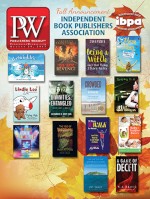The stories in Grudova’s The Doll’s Alphabet (Coffee House, Oct.) feature mermaids, maddening machines, and werewolves.
How did you select the stories included in your collection?
I posted a few stories on my Tumblr, and an editor from the White Review read them and signed me to write The Doll’s Alphabet. I would send stories to him as I finished, and he helped choose which stories went in.
Did you think about how the stories in the collection fit together? There are recurring images, such as sewing machines—were these part of the organizing principles?
I saw limitation of tone, style, and aesthetic as important to the book. I love inventories and indexes; initially I wanted to include an index of mentioned objects, to give a sense of all the stories as part of one piece. And I’ve used a sewing machine since a young age. My grandmother worked as a seamstress. I find a lot of parallels between sewing and writing. It’s a process of creation, something from the imagination, and looks very much like writing to me.
There’s an ambiguity in when and where the stories are set. Why this decision?
This collection takes from a lot of different eras. I think that comes from the internet: picking and choosing to create entertainment for yourself. The story “Agata’s Machine,” for me, is really about becoming obsessed online, especially at a young age. And about imaginary lives becoming removed from one’s present reality.
The Doll’s Alphabet blends many elements—horror, fantasy, feminist writing, among others. Did you always know the collection would pull from a number of different sources?
I always thought I’d grow up to be a children’s writer. A lot of children’s books I loved, like The Borrowers, are really creepy! That was something I thought about a lot. I’ve heard a lot of terms: weird fiction or magical realism, as opposed to realism. But I dislike the term realism quite intensely. I wonder, whose reality is that? The things I write are very realistic to me.
You have a fascination with a Victorian or Edwardian aesthetic. Will this make its way into your next book?
I’m working on a novel now, trying to aesthetically depart from this book and become obsessed with the 18th century instead. I didn’t like the 18th century, but after researching it, I love it. One of my favorite discoveries is a book by Horace Walpole—the entire book is a list of everything in his house! It’s very modernist, in a way.
How does your training in art history inform your writing?
The two Canadian artists I feel most connected to are Shary Boyle and Marcel Dzama. Dzama’s colors are very historical: certain browns and greens that make you think of 1919 or 1920. I think of my writing that way too. Sometimes I think of myself as a very, very cheap film director.



 Volume 264
Issue 35
08/28/2017
Volume 264
Issue 35
08/28/2017





